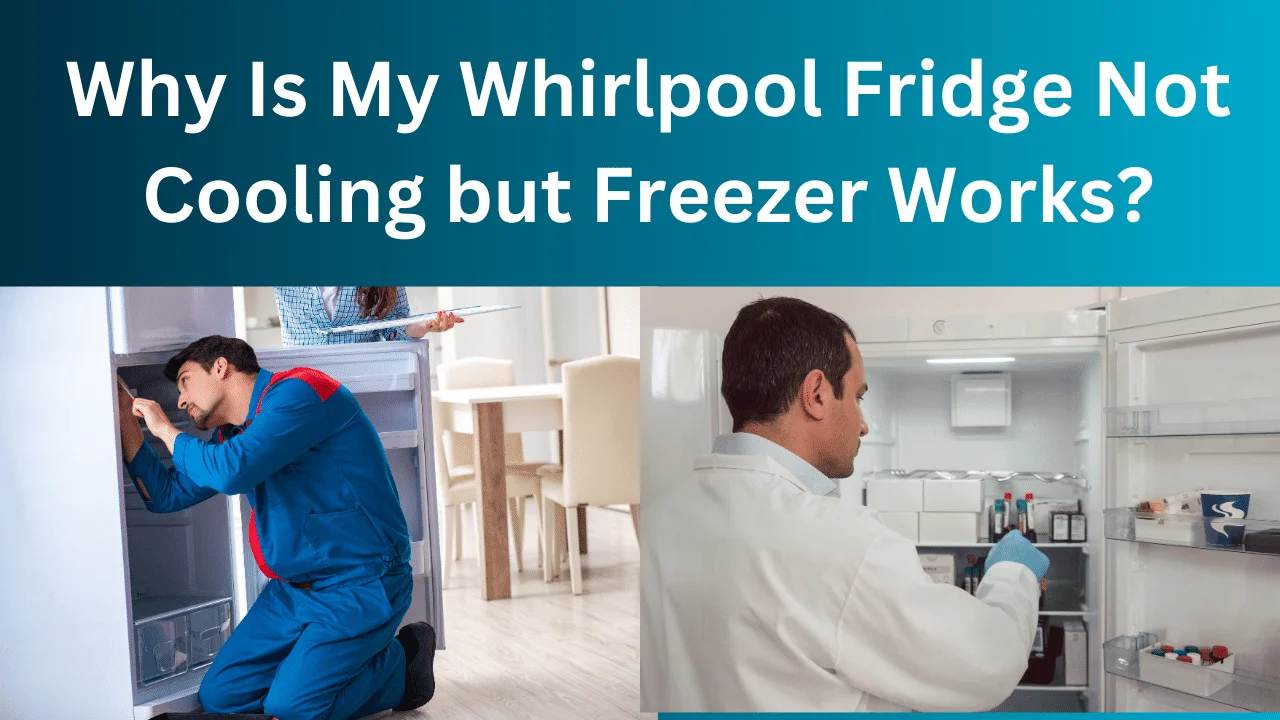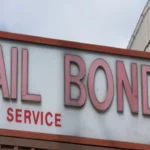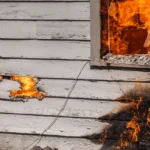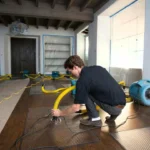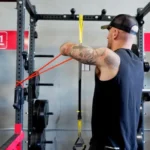Introduction
Every home needs a refrigerator; it keeps food fresh for longer and preserves it from spoilage. A frustrating problem to have is a Whirlpool refrigerator that won’t cool even though the freezer is working. As well as being very inconvenient, this problem can cause food to spoil. Here we’ll explore the many causes of this issue and provide some solutions for you to try.
Understanding Your Whirlpool Refrigerator
Reputed for producing long-lasting and energy-efficient refrigerators, Whirlpool is a household name in the appliance market. You can get the best cooling performance out of your refrigerator and freezer with these appliances. Problems can arise, though, as is the case with any complicated machine. If the refrigerator stops cooling but the freezer keeps running, there are some problems that need fixing.
Common Reasons for Whirlpool Fridge Not Cooling
Malfunctioning Evaporator Fan Motor
To transfer cold air from the freezer to the refrigerator, the evaporator fan motor is an essential component. The freezer stays icy while the fridge gets hot when it breaks.
Signs of a Faulty Evaporator Fan Motor
If the motor that drives the evaporator fan is malfunctioning, you may find that the refrigerator is not as cold as it should be or hear strange noises emanating from the freezer. Furthermore, a malfunction is evident if the fan is not running when you open the freezer door.
Replacing the Evaporator Fan Motor
To access the evaporator fan motor, turn off the power to the refrigerator, take off the back panel of the freezer, and detach the broken motor. Connect the new motor’s wires and fasten it into position to install it. To check if the problem has been fixed, put the refrigerator back together and turn it on.
Defrost System Malfunction
The evaporator coils are protected from frost buildup by the defrost system. When this mechanism isn’t working, frost builds up, blocking the airflow and eventually rendering the refrigerator useless for cooling.
Components of the Defrost System
The defrost heater, thermostat, and timer make up the defrost system. For defrosting to be effective, each of these parts must work as it should.
Diagnosing Defrost System Issues
By applying a continuity test to the defrost heater and thermostat with a multimeter, you can identify problems with the defrost system. If either part doesn’t hold up, it’s time to get a new one. To manually test if it starts the defrost cycle, you can advance the defrost timer.
Fixing Defrost System Problems
Changing out the broken part is the standard procedure for fixing defrost system issues. Take the defrost heater as an example; if it breaks, you’ll have to take the back panel off the freezer to get to it. Likewise, if the defrost thermostat or timer is broken, you should get a new one.
Blocked or Frosted Over Air Vents
The cold air from the freezer can easily circulate into the refrigerator thanks to the air vents. Inadequate cooling occurs when these vents are obstructed or covered with frost.
Identifying Blocked Air Vents
Looking for obstructions or frost buildup is a surefire way to spot blocked air vents. Food items placed too near the vents are a common obstructive factor.
Clearing Blocked Air Vents
Make sure nothing is blocking the air vents by rearranging the contents of the freezer and fridge. Turning off the refrigerator and letting the frost melt should defrost the freezer if frost buildup is the problem. The cold air should be able to flow correctly between compartments once the vents are clear.
Thermistor Problems
In order to control the cooling cycle, the thermistor, a sensor, communicates with the control board and keeps an eye on the temperature inside the refrigerator. The cooling process can be interrupted if the thermistor is defective and sends the wrong signals.
Testing the Thermistor
The thermistor can be tested by measuring its resistance at various temperatures using a multimeter. Inconsistent resistance readings at constant temperature indicate a faulty thermistor that requires replacement.
Replacing a Faulty Thermistor
Finding the defective thermistor inside the refrigerator, detaching its connections, and then installing a new one are the steps required to replace it. Reassemble the refrigerator only after you have checked that the new thermistor is securely attached.
Damper Control Assembly Issues
The amount of chilly air that enters the refrigerator can be adjusted by the damper control assembly. The refrigerator won’t cool down evenly if the door is broken or stuck.
Checking the Damper Control Assembly
Make sure there is no blockage or damage to the damper control assembly. There may be problems with cooling if the damper door does not open completely or gets stuck.
Fixing or Replacing the Damper Control Assembly
In order to repair or replace the damper control assembly, make sure the damper door can move freely and remove any obstructions. In order to get the cooling system working again, you have to replace the damaged assembly.
Additional Troubleshooting Tips
Check Temperature Settings
Verify that the refrigerator and freezer are set to the appropriate temperatures. Having the thermostat set too high or too low might be the source of the problem.
Inspect Door Seals
Make sure the door seals are in good repair. A decrease in the refrigerator’s cooling efficiency might result from damaged seals that allow cold air to escape. Repair damaged seals to ensure adequate cooling.
Clean Condenser Coils
A refrigerator’s ability to cool down is compromised when the condenser coils are dirty. If you want your coils to dissipate heat effectively, you need to clean them often to remove dust and debris.
Professional Assistance
It is recommended to consult an expert if the problem persists after attempting troubleshooting steps. Your Whirlpool refrigerator has complicated issues that only a trained professional can identify and fix.
Understanding the Role of Key Components
Evaporator Fan Motor
Function and Importance
In order for the refrigerator to draw cold air from the freezer, the evaporator fan motor is crucial. If it weren’t there, food would go bad in the fridge because it wouldn’t get enough cold air to keep the temperature stable.
Symptoms of Malfunction
Unusual noises emanating from the freezer, uneven cooling in the refrigerator section, and, in extreme circumstances, total airflow shutdown are common indications of a broken evaporator fan motor. A likely sign of a malfunctioning evaporator fan motor is a refrigerator that is warm inside while the freezer stays cold outside.
Replacement Process
You need to unplug the refrigerator, take off the freezer’s rear panel, and then disconnect the broken motor in order to replace the evaporator fan motor. After unplugging the old motor, plug in the new one and fasten it into place. Reconnect the refrigerator’s power cord after putting the back panel back together to see if the cooling problem has been fixed.
Defrost System
Components and Functionality
Important parts of the defrost system include the heater, thermostat, and timer. Collecting frost on the evaporator coils can limit airflow and lead to cooling issues; these components cooperate to keep that from happening.
Identifying Defrost System Failures
When the defrost system stops working, it causes the evaporator coils to get frosty, water to leak inside the refrigerator, and the internal temperature to rise. The defrost heater and thermostat can be troubleshooted by conducting continuity tests with a multimeter. A malfunction could also be indicated if the defrost timer is not advancing correctly.
Repairing the Defrost System
Fixing the defrost system is as simple as swapping out broken parts. To access the defrost heater, for example, you have to take off the freezer’s rear panel. Once there, you can disconnect the broken heater and replace it. The same holds true for fixing a broken defrost thermostat or timer.
Air Vents
Importance of Airflow
The efficient transfer of cold air from the freezer to the refrigerator relies on air vents. Both sections are kept at their specified temperatures by ensuring proper airflow.
Common Obstructions
Food items placed too near the vents, frost buildup, or debris accumulation can all obstruct the air vents. The effectiveness of the refrigerator’s cooling system can be drastically diminished due to these obstructions.
Maintaining Clear Air Vents
Keep the air vents clear by checking for and removing any obstructions on a regular basis. Make sure there’s enough room around the vents to allow air to circulate, and don’t stuff the fridge and freezer to bursting. Turning off the refrigerator and letting the frost melt should defrost the freezer if frost buildup is the problem.
Thermistor
Role in Temperature Regulation
In order to control the cooling cycle, the thermistor, a type of sensor, communicates with the control board and measures the internal temperature of the refrigerator. By regulating the cooling process as required, it keeps the refrigerator at a constant temperature.
Symptoms of a Faulty Thermistor
Inconsistent temperatures, inaccurate readings, and a complete breakdown of the cooling cycle can all result from a malfunctioning thermistor. The inefficiency of the system and the spoilage of food are common outcomes of these symptoms.
Testing and Replacing the Thermistor
The thermistor can be tested by measuring its resistance at different temperatures using a multimeter. The thermistor needs to be changed if the readings aren’t consistent. To change it, find the thermistor, unplug it, and then plug in a new one, making sure to tighten all of the connections.
Damper Control Assembly
Function and Significance
You can control how much cold air comes into the refrigerator from the freezer with the damper control assembly. Its proper functioning is dependent on the two sections’ ability to keep their temperatures in equilibrium.
Identifying Damper Issues
There won’t be enough cold air to cool the fridge compartment if the damper control assembly is broken or stuck shut. Unusual swings in fridge temperature or obvious damage to the damper door are telltale signs of a damper problem.
Repairing or Replacing the Damper Control Assembly
Before attempting to fix or replace the damper control assembly, make sure the door to the damper is clear of any obstacles. To fix a broken assembly, take it apart and put a new one in its place. Verify that the replacement damper control assembly is fastened and positioned correctly.
Preventive Maintenance Tips
Regular Cleaning
If you clean the condenser coils, air vents, and door seals of your refrigerator on a regular basis, you won’t have to worry about cooling problems. To keep the condenser coils clean and efficient, you should clean them twice a year.
Temperature Settings
The user manual will always tell you what the optimal temperature settings are. The refrigerator’s cooling efficiency can be affected by incorrect settings, which can lead to overwork or underperformance.
Proper Food Storage
Do not stuff the refrigerator and freezer to their limits. To make sure air can flow freely, make sure there’s adequate room around the vents. To avoid clogs and even cooling, keep food items in an organized storage space.
Routine Inspections
Check the thermistor, air vents, defrost system, evaporator fan motor, and damper control assembly, among other refrigerator components, on a regular basis. You can prolong the life of your appliance and avoid costly repairs by catching problems early on.
Frequently Asked Questions
Why Is My Whirlpool Refrigerator Warm but Freezer Cold?
This issue often occurs due to a malfunctioning evaporator fan motor, defrost system failure, blocked air vents, or problems with the damper control assembly. Identifying and addressing these issues can resolve the problem.
How to Fix a Whirlpool Fridge That Is Not Cooling but Freezer Works?
To fix this issue, you should check and replace faulty components such as the evaporator fan motor, defrost system parts, and thermistor. Additionally, clear any blockages in the air vents and ensure the damper control assembly is functioning correctly.
What Causes a Whirlpool Refrigerator to Stop Cooling?
Common causes include evaporator fan motor failure, defrost system malfunction, blocked air vents, thermistor problems, and damper control assembly issues. Addressing these causes typically involves troubleshooting, repairing, or replacing faulty components.
How to Repair a Whirlpool Fridge That Isn’t Cooling?
Repairing a Whirlpool fridge that isn’t cooling involves diagnosing the root cause of the problem and replacing or repairing the faulty components. This may include the evaporator fan motor, defrost system parts, thermistor, and damper control assembly.
Whirlpool Refrigerator Freezer Working but Fridge Not Cold – What to Do?
If the freezer works but the fridge is not cold, check for issues with the evaporator fan motor, defrost system, air vents, thermistor, and damper control assembly. Follow the troubleshooting steps outlined in this article to identify and fix the problem.
Also Read: How to Put out Electrical Fire?
Conclusion
Several issues can cause a Whirlpool refrigerator to not cool while the freezer is working. These include a faulty evaporator fan motor, a failed defrost system, obstructed air vents, thermistor problems, or damper control assembly problems. You can fix the issue and get your refrigerator cooling efficiently again if you know what to look for and follow the troubleshooting steps. To make sure the diagnosis and repair are accurate, it’s best to seek professional help if needed. Your Whirlpool refrigerator will last longer and function better if you take care of it regularly and fix any problems quickly.

Shannon Reyes is a seasoned writer with a knack for crafting engaging blogs on a variety of service industries, including plumbing, cleansing, moving, pest control, and roofing. With a keen eye for detail and a passion for helping readers navigate complex topics, Shannon brings her expertise to life through informative and accessible content.

